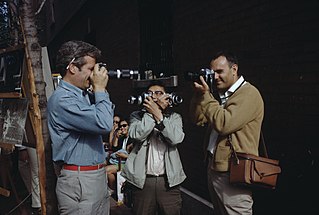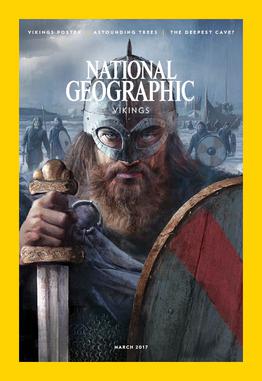
Photography is the art, application, and practice of creating images by recording light, either electronically by means of an image sensor, or chemically by means of a light-sensitive material such as photographic film. It is employed in many fields of science, manufacturing, and business, as well as its more direct uses for art, film and video production, recreational purposes, hobby, and mass communication.

A photograph is an image created by light falling on a photosensitive surface, usually photographic film or an electronic image sensor, such as a CCD or a CMOS chip. Most photographs are now created using a smartphone or camera, which uses a lens to focus the scene's visible wavelengths of light into a reproduction of what the human eye would see. The process and practice of creating such images is called photography.

A photographer is a person who makes photographs.

Kodachrome is the brand name for a color reversal film introduced by Eastman Kodak in 1935. It was one of the first successful color materials and was used for both cinematography and still photography. For many years, Kodachrome was widely used for professional color photography, especially for images intended for publication in print media.

National Geographic is an American monthly magazine published by National Geographic Partners. The magazine was founded in 1888 as a scholarly journal, nine months after the establishment of the society, but is now a popular magazine. In 1905, it began including pictures, a style for which it became well-known. Its first color photos appeared in the 1910s. During the Cold War, the magazine committed itself to present a balanced view of the physical and human geography of countries beyond the Iron Curtain. Later, the magazine became outspoken on environmental issues.
Getty Images Holdings, Inc. is an American visual media company and supplier of stock images, editorial photography, video, and music for business and consumers, with a library of over 477 million assets. It targets three markets—creative professionals, the media, and corporate.

Sergey Mikhaylovich Prokudin-Gorsky was a Russian chemist and photographer. He is best known for his pioneering work in colour photography and his effort to document early 20th-century Russia.

Color photography is a type of photography that uses media capable of capturing and reproducing colors. By contrast, black-and-white or gray-monochrome photography records only a single channel of luminance (brightness) and uses media capable only of showing shades of gray.

BENlabs, formerly BEN Group Inc, is a Los Angeles–based product placement, influencer marketing and licensing company. The company offers AI-driven product placement, influencer marketing services, music partnerships, rights clearance, and personality rights management services for the entertainment industry.

Stock photography is the supply of photographs that are often licensed for specific uses. The stock photo industry, which began to gain hold in the 1920s, has established models including traditional macrostock photography, midstock photography, and microstock photography. Conventional stock agencies charge from several hundred to several thousand US dollars per image, while microstock photography may sell for around US$0.25 cents. Professional stock photographers traditionally place their images with one or more stock agencies on a contractual basis, while stock agencies may accept the high-quality photos of amateur photographers through online submission.
The National Geographic Society – Palomar Observatory Sky Survey was a major astronomical survey, that took almost 2,000 photographic plates of the night sky. It was conducted at Palomar Observatory, California, United States, and completed by the end of 1958.

Wedding photography is a specialty in photography that is primarily focused on the photography of events and activities relating to weddings. It may include other types of portrait photography of the couple before the official wedding day, such as a pre-wedding engagement session. On the wedding day, the photographer(s) will provide portrait photography as well as documentary photography to document the different wedding events and rituals throughout the day(s).

Digital photography uses cameras containing arrays of electronic photodetectors interfaced to an analog-to-digital converter (ADC) to produce images focused by a lens, as opposed to an exposure on photographic film. The digitized image is stored as a computer file ready for further digital processing, viewing, electronic publishing, or digital printing. It is a form of digital imaging based on gathering visible light.
David Doubilęt is an underwater photographer known primarily for his work published in National Geographic magazine, where he is a contributing photographer and has been an author for 70 feature articles since 1971. He was born in New York City and started taking photos underwater at the young age of 12. He started with a Brownie Hawkeye in a rubber anesthesiologist's bag to keep the water out of the camera. He lived with his family in New York City and spent summers in Elberon New Jersey exploring the Atlantic. He later worked as a diver and photographer for the Sandy Hook Marine Laboratories in New Jersey and spent much of his youth in the Caribbean as a teenage dive instructor in the Bahamas where he found his motivation to capture the beauty of the sea and everything in it. His wife is the photographer Jennifer Hayes.
A chromogenic print, also known as a C-print or C-type print, a silver halide print, or a dye coupler print, is a photographic print made from a color negative, transparency or digital image, and developed using a chromogenic process. They are composed of three layers of gelatin, each containing an emulsion of silver halide, which is used as a light-sensitive material, and a different dye coupler of subtractive color which together, when developed, form a full-color image.
The following outline is provided as an overview of and topical guide to photography:
The red shirt school of photography is a trend which first became popular in the 1950s. It was pioneered by National Geographic photographers, who had subjects wear, or chose subjects who wore overly colorful clothes. The earliest use of such techniques can be traced back to autochrome pioneers of the 1920s - like Gervais Courtellement - who worked on National Geographic assignments worldwide. Originally meant to describe the work of many of the National Geographic photographers of the late 1950s and early 1960s, the term is loosely applied to the creation of any such images.
Even though Kodachrome was already unnaturally bright, photographers ... splashed the strongest possible colors in their pictures so that they would be more effective in print. One result was that the staff photographers - who were constantly being sent to colorful places to slake what was seen as the public's unquenching thirst for colorful scenes - would often find themselves needing more color to take advantage of the color film and would resort to placing the people in costume.

Photographic film is a strip or sheet of transparent film base coated on one side with a gelatin emulsion containing microscopically small light-sensitive silver halide crystals. The sizes and other characteristics of the crystals determine the sensitivity, contrast, and resolution of the film. Film is typically segmented in frames, that give rise to separate photographs.

Documerica was a program sponsored by the United States Environmental Protection Agency to "photographically document subjects of environmental concern" in the United States from about 1972 to 1977. The collection, now at the National Archives, contains over 22,000 photographs, more than 15,000 of which are available online. The title is a portmanteau of "documentary" and "America".
Jacques Alexandre is a French photographer known for his artistic photography of women, children, and landscapes in two main artistic styles: First his romantic "impressionism period" in the 1970s, influenced by the impressionism paintings and then his "hyperrealistic period" starting in the 1980s, with straight compositions and strong colors. He is also well known for his lifestyle images for the medias worldwide.













